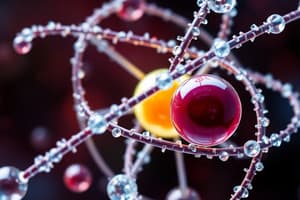Podcast
Questions and Answers
What is the charge of a proton?
What is the charge of a proton?
- Positive (correct)
- Negative
- Zero
- Neutral
Which particle has a negligible mass compared to the nucleus?
Which particle has a negligible mass compared to the nucleus?
- Proton
- Isotope
- Neutron
- Electron (correct)
What defines the atomic number of an element?
What defines the atomic number of an element?
- Number of neutrons
- Number of electrons
- Mass of the nucleus
- Number of protons (correct)
What component of an atom determines its chemical properties?
What component of an atom determines its chemical properties?
Which particle is responsible for the mass and charge of an atom?
Which particle is responsible for the mass and charge of an atom?
Which subatomic particle was discovered by J.J. Thomson in 1897?
Which subatomic particle was discovered by J.J. Thomson in 1897?
What makes up more than 99.9% of an atom's mass?
What makes up more than 99.9% of an atom's mass?
What uniquely identifies an element and determines its atomic number?
What uniquely identifies an element and determines its atomic number?
Flashcards are hidden until you start studying
Study Notes
Atomic Structure: A Deep Dive into Protons, Neutrons, Electrons, and Atomic Number
Atomic structure refers to the composition of atoms, the fundamental building blocks of matter. Atoms consist of three basic particles: protons, neutrons, and electrons, which are responsible for the mass and charge of atoms. Here, we explore the subtopics of protons, neutrons, electrons, and atomic number in detail.
Protons
Protons are positively charged particles found in the nucleus of an atom. Each element is defined by the number of protons in its nucleus, known as the atomic number (Z). Protons have a mass of approximately 1 atomic mass unit (amu) or 1.67 x 10^-27 kg, and their charge is equal but opposite to the negative charge of the electron.
Neutrons
Neutrons are electrically neutral particles found in the nucleus of an atom, alongside protons. Neutrons have no charge and a mass of approximately 1 amu, or 1.67 x 10^-27 kg. The number of neutrons in an atom's nucleus is not fixed and can vary, leading to isotopes.
Electrons
Electrons are negatively charged particles that orbit the nucleus in well-defined energy levels called electron shells. They follow a random pattern within these shells. The mass of an electron is approximately 9.1 x 10^-31 kg, which is negligible compared to the mass of the nucleus.
Atomic Number
The atomic number (Z) of an element refers to the number of protons in the nucleus of an atom. This number uniquely identifies an element and determines its chemical properties. Each element has a specific number of protons, and as a result, a specific atomic number.
Atoms are not only composed of protons, neutrons, and electrons, but the arrangement of these particles within an atom is also crucial. The nucleus, containing protons and neutrons, is much smaller than the atom as a whole, yet it accounts for more than 99.9% of the atom's mass. The electrons orbit the nucleus in distinct energy levels called electron shells, and their arrangement contributes to an atom's chemical properties.
The discovery of these subatomic particles and their roles in atomic structure have been significant milestones in the history of physics. J.J. Thomson discovered the existence of electrons in 1897, and Sir Ernest Rutherford proved the existence of protons in 1919. Since then, scientists have continued to study the structure of atoms in detail, leading to a deeper understanding of the world around us.
In summary, the atomic structure of an atom is composed of protons, neutrons, and electrons. The number of protons in an atom's nucleus defines its atomic number, which uniquely identifies an element. The arrangement of these particles within an atom is crucial to its properties and behavior. As a result, atoms can join together to form molecules, which are the building blocks of all matter.
Studying That Suits You
Use AI to generate personalized quizzes and flashcards to suit your learning preferences.




